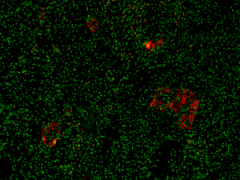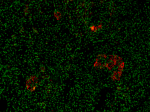- Clone
- A17193J (See other available formats)
- Regulatory Status
- RUO
- Other Names
- CD6 ligand, Activated Leukocyte Cell Adhesion Molecule (ALCAM)
- Isotype
- Mouse IgG2b, κ
- Ave. Rating
- Submit a Review
- Product Citations
- publications

-

Human paraffin-embedded pancreas tissue slices were prepared with a standard protocol of deparaffinization and rehydration. Antigen retrieval was done with Sodium Citrate H.I.E.R. 1X at 95°C for 40 minutes. Tissue was washed with PBS/0.05% Tween 20 twice for five minutes and blocked with 5% FBS and 0.2% gelatin for 30 minutes. Then, the tissue was stained with 10 µg/mL of purified anti-human CD166 (clone A17193J) at 4°C overnight, followed by 2.5 µg/mL of anti-mouse IgG (clone Poly4053) Alexa Fluor® 594 (red) for two hours at room temperature. Nuclei were counterstained with DAPI (green). The image was captured with a 10X objective.
| Cat # | Size | Price | Quantity Check Availability | Save | ||
|---|---|---|---|---|---|---|
| 397802 | 100 µg | 235€ | ||||
CD166, also known as the CD6 ligand or the Activated Leukocyte Cell Adhesion Molecule (ALCAM), is a 100-105 kD transmembrane glycoprotein. It belongs to the Ig superfamily of proteins and expressed on activated T cells, activated monocytes, epithelial cells, fibroblasts, and neurons. CD166 plays an important role in mediating adhesion interactions between thymic epithelial cells and CD6+ cells during intrathymic T cell development. Recently CD166 has also been used as a potential cancer stem cell marker. The antibody reacts with human activated leukocyte cell adhesion molecule (ALCAM).
Product DetailsProduct Details
- Verified Reactivity
- Human
- Antibody Type
- Monoclonal
- Host Species
- Mouse
- Immunogen
- Recombinant human CD166
- Formulation
- Phosphate-buffered solution, pH 7.2, containing 0.09% sodium azide.
- Preparation
- The antibody was purified by affinity chromatography.
- Concentration
- 0.5 mg/ml
- Storage & Handling
- The antibody solution should be stored undiluted between 2°C and 8°C.
- Application
-
IHC-P - Quality tested
- Recommended Usage
-
Each lot of this antibody is quality control tested by formalin-fixed paraffin-embedded immunohistochemical staining. For immunohistochemistry, a concentration range of 5 - 10 µg/ml is suggested. It is recommended that the reagent be titrated for optimal performance for each application.
- Product Citations
-
- RRID
-
AB_2814379 (BioLegend Cat. No. 397802)
Antigen Details
- Structure
- A type I transmembrane glycoprotein belonging to the Ig superfamily of proteins.
- Distribution
-
CD166 is expressed on activated T cells, activated monocytes, epithelial cells, fibroblasts, and neurons.
- Function
- Play an important role in mediating adhesion interactions between thymic epithelial cells and CD6+ cells during intrathymic T cell development.
- Ligand/Receptor
- CD6
- Cell Type
- B cells, Dendritic cells, Mesenchymal Stem Cells, Tregs
- Biology Area
- Cell Biology
- Molecular Family
- CD Molecules
- Antigen References
-
- Aruffo A, et al. 1997. Immunol Today. 18(10):498.
- Patel DD, et al. 1995. J. Exp. Med. 181:2213.
- Bowen MA, et al. 1995. J. Exp. Med. 181:1563.
- Horst D, et al. 2009. Cancer Invest. 8:844-50.
- Gene ID
- 214 View all products for this Gene ID
- UniProt
- View information about CD166 on UniProt.org
Related FAQs
Other Formats
View All CD166 Reagents Request Custom Conjugation| Description | Clone | Applications |
|---|---|---|
| Purified anti-human CD166 | A17193J | IHC-P |
Compare Data Across All Formats
This data display is provided for general comparisons between formats.
Your actual data may vary due to variations in samples, target cells, instruments and their settings, staining conditions, and other factors.
If you need assistance with selecting the best format contact our expert technical support team.
-
Purified anti-human CD166

Human paraffin-embedded pancreas tissue slices were prepared...
 Login / Register
Login / Register 








Follow Us